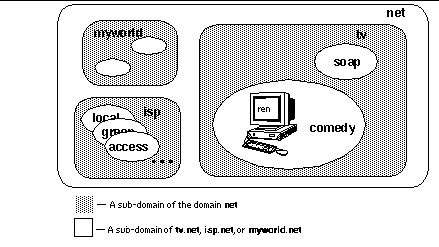Domain Name Service Background
DNS gives different groups responsibility for subsets of names. Each subset or level is called a domain. At the top level of the DNS hierarchy are a small number of large domains, such as com (for commercial organizations). Individual organizations set up their own domains within these domains (sun.com, oracle.com, stanford.edu). Domains, in turn, can have subdomains. Contact your ISP for a domain name, which they can register for a fee.
The host name of a system, together with its full domain specification, makes up a complete DNS name. For example, Figure 9-1 shows such a DNS name: ren.comedy.tv.net. The machine ren is a node residing in the subdomain comedy within the domain tv, which is in the domain net.
Figure 9-1 Example of DNS Domains

Every domain has two or more systems that keep a database of DNS names for that domain. These systems also contain the DNS names of the subdomains, unless this responsibility is delegated to systems in the subdomain. Thus, there are several systems that contain the database for the domain net. In that database, there is a delegation entry pointing to a system that keeps the database for tv. The DNS database for tv contains entries for delegating the domains soap and comedy. The database for comedy contains the host address for ren.
The DNS system of resolving names is strictly hierarchical. Using the previous example, the system that acts as the DNS server for the domain tv translates a host name to a host address only if that host name exists directly within the domain. All other host names are forwarded to the appropriate sub-domain for resolution. (Thus, the name ren.comedy.tv.net is forwarded from tv's DNS server to the DNS server for the subdomain tv for resolution.
- © 2010, Oracle Corporation and/or its affiliates
